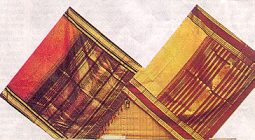TEXTILES
Cotton fabrics || Silk weaves ||Tie and dye fabrics || Hand-printed and painted fabrics || Folk embroideries || Woolen weaves || Saree Blouse Embroidery
India has a wide range of textiles of varied designs and manufactured by numerous techniques when compared to other countries in the world. The styles depend upon the location of the place, climatic conditions, cultural influences and trade contacts.
The varied topography of India from the snowy mountains to the rich river valleys and from the lush forests to the arid deserts as well as the various cultures brought down here from the invaders have influenced the growth of a number of textile weaves.

A weaver in his work
The rich river plains have a softer texture and milder colors with linear patterns and well-defined borders. Mostly floral patterns are used for the decorations of the cloth. In the Deccan region, the colors match the black alluvial soil of the area. Dark maroon, bottle green and turquoise blue are common colors here. The dry and hot clime of the Southern states, which comprises Tamilnadu, Karnataka and Andhra, favors rich and luminous colored silks. The Himalayan area, which consists of Ladakh, Himachal Pradesh and Northern parts of Uttar Pradesh, concentrates on woolen weaves with highly geometric patterns woven in tapestry weave in the primary colors.
Cotton Fabrics
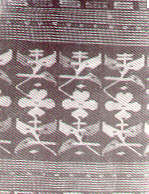
Jamdani work
The cotton saris of West Bengal are called Jamdani and they follow the traditional patterns. Twisted yarn is closely woven together and so the saris are more lasting. Initially the Jamdani saris were woven for the nobles of North India. Now this art is still practiced in Tanda and Varanasi. This inlay technique is fully indigenous. This Jamdani technique of patterning is found in the cotton centers of Venkatagiri in Andhra, Morangfi in Manipur and Kodialkarruppar in Tamilnadu. From the textile city of Coimbatore and Tirupur Cotton Tshirts are made and exported through out the world.
Chanderi is noted for fine cotton saris and shallus, wraps worn by the womenfolk. The warp is silk and the weft is cotton. The saris carry motifs or roundels or asharfi buti on the body.
Maheshwar on the banks of the river Narmada weaves fine cotton saris with tiny checks, which combine complimentary colors together. Very soft colors are used for the dyeing. Maharastrian women wear these saris > with the flowing pleats in the front while the back is tucked into the waist.
The Illkal saris of Karnataka and the Narayanpet saris of Andhra also have the same style but they are woven in dark earthen colors. In Illkal, the naturally grown indigo is used for dyeing purposes. Andhra has a rich variety in cotton saris. Gadwal and Wanaparti produce saris of thick cotton body mostly in checks with a contrasting silk border and pallu worked in gold. Nander is famous for its fine quality cottons saris richly worked in gold thread with silk border. Venkatagiri manufactures saris of the Jamdani technique with stylized motifs woven in half cotton and half gold threads.
Silk Weaves
In India, Varanasi is one of the most famous silk weaving centers. Originally, it produced cotton and was a cotton-weaving center. Silk weaving started in Varanasi for producing saris, Dhotis and chaddars for use in worship. Later with the growth of trade and demand for silk fabrics, it began to produce a variety of textiles in silk for personal uses. The specialty of the region is the heavy gold brocade, which has an extra weft of rich gold thread running across the warp threads.The Amru silk brocades of Varanasi are very famous. The amru saris are the Butidar ones enclosed by a border and a heavy pallu of flowering bushes or the flowing mango pattern.
The Baluchar technique of weaving brocades with untwisted silk thread was developed in the Murshidabad district of West Bengal. It is based upon the miniature paintings of India. The specialty of the Baluchar saris is the large Pallu with a central pattern of flowing Kalgas, the mango design enclosed by repetitive frames of miniatures. Gujarat is an important brocade center with a class of its own. Extra weft brocade developed in Gujarat only. Silk weaving continues in Ridrol in Mehsana District and Jamnagar in Saurashtra in Gujarat . Materials for Ghagras, skirts, saris, ordhnis, cholis and many items for religious purposes are also woven here. Small Torans to be hung outside the family temples are also made.
South India has a class of its own in silk saris. Heavy lustrous silk with broad borders and elaborate pallus are made here. Contrasting colors are used to produce a harmonious blend of colors. Traditionally the pattern is a part of the woven fabric and not an extra weft. The checks and strips are woven into the warp and weft. Kancheepuram, Tanjore and Kumbakonam are the important silk centers in Tamilnadu. Sangareddy in Andhra, Kolegal and Molkalmoru in Karnataka are also famous silk weaving centers. Tanjore is specialized in weaving the all -over gold saris used for weddings and temple uses. Molkalmoru has its own distinct tradition of simple ikat weave combined with a rich gold border carrying stylized motifs.
Tie and dye fabrics
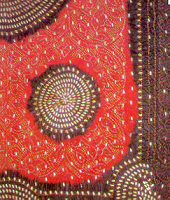
Bandani work
Bleached cloth is folded lengthwise and then widthwise into four folds. One side of the width, which has the two ends of the sari, has the intricate patterns of the Pallu, while the border pattern runs down on one side. The patterns on the body are then distributed all over the surface. The dyer indicates the designs to be tied. Then tying the cloth into tiny knots creates the outline of the pattern. Womenfolk generally do the tying works.
Gujarat does saris, which are dark in background color while Rajasthan has developed another technique wherein the background color is light and the patterns are in dark shades. Kutch produces the finest Bandhanis in India. Mandvi and Bhuj are also other important bandhani producing centers. The Khatri community of Gujarat is known for their fine quality dyeing.
The Gharchola saris carry tied and dyed patterns. These saris are traditionally bought for weddings and they carry a gold thread for the checks with small golden motifs like peacock or lotus in the center. These saris are tied and dyed in Kutch. The final red color of the Gharchola saris are dyed in Jamnagar because of the special quality of water there. Rajkot in Saurastra is another important center for bandhanis. In Rajasthan, Jodhpur, Jaipur and Sikar are the notable centers. Sikar produces one of the finest Bandhanis. Another form of tie and dye in Rajasthan is the Lahriya and Mothra.
Here the opposite ends of the length of the cloth are pulled and rolled together. They are then tied and dyed in different colors producing multicolored lines. Mothra is formed when the same process is repeated by using the opposite ends. This is done only in Jaipur and Jodhpur. Lahriya technique is used for making turbans for the Rajputs of Rajasthan.
In Bihar, the Bandhani technique is worked to create bold patterns in single colors. The same technique is used in Madurai in Tamilnadu to produce the famous Sungudi saris, which are a must for many communities during marriages in the South. The technique of tie and dye of threads before weaving is known as Patola.
Internationally it is called as Ikat. Ikat weaving is done in Andhra Pradesh and Odisha. In Andhra it is known as Pagdu Bandha Baddabhasi or Chilka. Ikat furnishing weaving is done in the whole of Nalgonda districtt of Andhra. Odisha has a distinct style of Ikat known as Bandha. In this method the single ikat is worked in the warp and the borders are prepared separately.
Hand - printed and Painted Fabrics
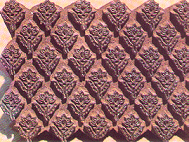
Wooden block used for
printing in fabrics
Direct printing is popular throughout India and it involves a bleached cotton or silk fabric printed with the help of carved wooden blocks. In hand block printing around three or four colors are used.
In the resist method, a paste is made up of different materials and it is used for the printing areas, which are required to resist the dye. The fabric is then immersed in the dye.
Batik
Batik is a medium that lies somewhere between art and craft, and is believed to be at least 2000 years old. The Batik technique is a development of resist printing. The fabric is painted with molten wax and then dyed in cold dyes after which the cloth is washed in hot water. The wax melts and the pattern emerges. The effect of this resist technique is soft and subdued and the outlines are not clearly defined.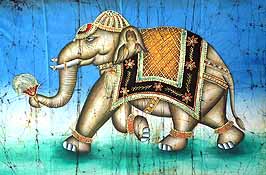
Batik work
After the first waxing the fabric is dipped into a dye bath whose color is the lightest tone of those to be used. When the piece has dried, we see an area of white and an area of cloth that is the color of the first dyeing. Wax is now applied to those parts in which we wish to retain the first color, and the entire fabric is immersed in the second dye bath whose color is darker in tone than the first.
This process is repeated until the darkest tone required in the final design has been achieved. When the fabric, now almost wholly waxed, has dried it is placed between sheets of absorbent paper and a hot iron applied. As the sheets of paper absorb the wax they are replaced by fresh sheets until the wax is removed. At this point the final design is seen clearly for the first time.
In another method of printing, mordants are used. The cloth is first printed with mordants and then immersed in the dye. Only the sections, which have absorbed the mordant, can absorb the dye. The cloth is then washed in flowing waters and allowed to dry in the sun when the colors develop. Then the untreated sections are bleached with local ingredients.
Hand printing is practiced in Jaipur, Sanganer, Bagroo, Apli and Barmer in Rajasthan. In Gujarat, Mandvi, Dhamardhka, Mundra, Anjar, Jamnagar, Surrendranagar, Jaitpur, Ahmedabad, Baroda and Deesa are the important centers of printing fabrics. Mandvi and Anjar in Kutch district of Gujarat use both direct printing as well as resist printing.
Delhi has many printing establishments, which cater to both the internal and the external markets. Farukhabad in Uttar Pradesh is an important printing center and it produces bed covers, curtains, and hangings for Export.
Mausilipatnam in Andhra Pradesh has printers who are specialized in hand printing, Kalamkari printing, Resist printing, block printing as well as Batik works. Hand- painted Batik using locally grown indigo dyes is famous here.
Tanjore in Tamilnadu produces fine quality hand printed saris with the resist method in a village called Kodial. Gold work patterns are woven in the body of the sari and the outlines are worked with a combination of Kalamkari and printing which produces a rich and delicate look.
Folk Embroidery
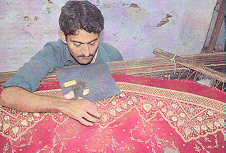
Embroidery work being done
Women embroider clothes for their personal use, for their children, their husbands, the elderly members of the family, etc. The people connected with the pastoral occupation prepare embroidered animal decorations. Decorative covers for the horns, forehead etc, for the bulls, the horses ,etc are prepared. The Rabaris of Kutch district in Gujarat do some of the finest embroidered decorations for the camel.
Embroidered pieces are also prepared for use during festivals, marriages and other important social functions. The embroidered or applique work called Dharaniya is an important decoration for the homes of Saurashtra and Kutch people. Embroidered Torans are put on the walls during festivals. Long Pattis, running embroidered strips cover the rafters.
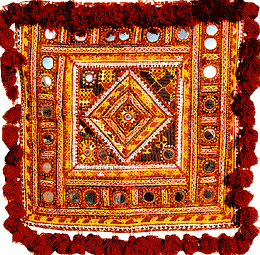
Mirror work in cloth
Sauurashtra also makes embroidered quilts. Kutch prepares quilts with applique works and also makes quilts from small multi- colored cloth pieces. Bikaner has a distinct style of embroidery, which is prepared on woolen ordhnis with woolen thread. They stimulate the Bandhani effect.
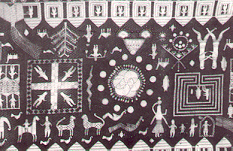
Phulkari work
The hill areas of Himachal Pradesh produce a double-sided embroidery known as Chamba Rumal.
This may be of the simple folk type or the classical form, which has simplified versions of miniature paintings of Pahari.
Bihar has a rich variety of embroidery works. The Akshida is famous here and it has embroidery work throughout the whole surface like the Bagh. Applique work of Odisha is prepared in Pipli, near Puri known for the Jagannath Temple. Here special canopies, fans, umbrellas, etc used in the famous Rath Yatra Festival are made.
The Kasuti embroidery of Karnataka is a stylized form with stitches based on the texture of the fabric. Negi, Gavanti and the Menthi are the three different types of stitches used Bead Works
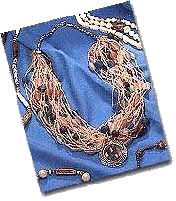
The design is woven with thread and needle. The work is done row by row on a tri-bead system, three beads being taken up at each stitch. On the return row, the stitching of the beads moves one position forward, so that a tight network is created. Usually the background is white with the pattern in different colors. The beadwork of Saurashtra and Kutch is very special. This work is not found in any other part of India.
Woolen Weaves
The shawls of Kashmir are well known throughout the world. They are made of superfine quality wool with intricate designs and excellent workmanship. They are reputed in the international market for several centuries. Kashmir makes a range of shawls like the Kani shawl, the double colored pashima, the soft Santoosh, the majestic woolen shawl, the Dhussa, the men's long shawl with its woven border and the fine Ambli or embroidered shawls.Kashmir is known for the Kani shawls for several centuries. The Aini- Akbari, written during the reign of Akbar mentions it and says that during the 18th century merchants used to come from all over the world to purchase it. They were worth their weight in gold then. The designs of the shawls are very complicated, that individual craftsmen prepare small pieces of the shawl and then later they were joined together. One of the methods to detect whether a shawl is a Kani shawl or not is to check at its back whether it has been woven as a separate piece or as a whole one.
Embroidery is also a fine art of the Kashmiri people. The double-sided shawl called Dorukha is a fine piece, in that, the right side cannot be differentiated from the wrong side.
In the Aksi shawl, the design is produced on one side by splitting the warp threads into half, leaving the other side plain or embroidered with another pattern.
The Santoosh woolen shawls are made from special wool, which is taken from the underside of the wild Pashima goats, which are found at high altitudes of the Kashmiri hills. The wool is first collected, sorted and then spun by hand by experts and then woven. The finished product is light and extremely warm.
The Himalayan region also produces many other varieties of shawls and tweeds for local usage. The shawls carry motifs inspired by the Buddhist traditions, the swastika, etc.



